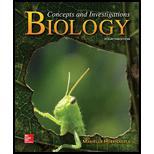
Concept explainers
Introduction:
The variety of life on earth is defined as biodiversity. The genetic diversity, species diversity and ecosystem diversity are the three levels of biodiversity. The amount of variation that occurs in a species is known as
Answer to Problem 1MCQ
Correct answer:
Earthquakes are not the reason for the loss of biodiversity. Therefore, option a. is correct.
Explanation of Solution
Reason for the correct statement:
The loss of biodiversity is because of the habitat destruction, non-native species and over-exploitation. Biodiversity includes the variation in species, not the number of individuals, so it is not exploited by natural disasters.
Option a. is given as “Natural disasters such as earthquakes”.
As, “Natural disasters, such as earthquakes is not one of the main cause of today’s biodiversity crisis”, is the right answer.
Hence, the option a. is correct.
Reasons for the incorrect statements:
Option b. is given as “Habitat destruction and degradation”.
Habitat destruction involves the cutting of trees from large areas that is also known as deforestation. As the plants absorb carbon-dioxide and release oxygen, this maintains the cycle of gases in animals. Deforestation may result into oxygen sink which affects the diversity of species. The cutting of trees also leads to the soil erosion, which disturbs the plant species. So, it is a wrong answer.
Option c. is given as “Overexploitation”.
Overexploitation of species involves harvesting the members of species faster than they can reproduce. This is one of the main causes of biodiversity exploitation. So, it is a wrong answer.
Option d. is given as “Introduction of nonnative species”.
When new species enter a new location, they affect the local habitat and are known as nonnative species. These new species are not related to existing species and they may disturb the biodiversity. So, it is a wrong answer.
Hence, options b., c., and d. are incorrect.
The loss of biodiversity is due to the destruction and degradation of habitat, fast harvesting of the members of species and the involvement of invasive species.
Want to see more full solutions like this?
Chapter 40 Solutions
Biology: Concepts and Investigations
- When beta-lactamase was isolated from Staphylcoccus aureus and treated with a phosphorylating agent, only the active site, serine was phosphorylated. Additionally, the serine was found to constitute 0.35% (by weight) of this beta-lactamase enzyme. Using this, calculate the molecular weight of this enzyme and estimate the number of amino acids present in the polypeptide.arrow_forwardBased on your results from the Mannitol Salt Agar (MSA) media, which of your bacteria were mannitol fermenters and which were not mannitol fermenters?arrow_forwardhelp tutor pleasearrow_forward
- Q8. A researcher wants to study the effectiveness of a pill intended to reduce stomach heartburn in pregnant women. The researcher chooses randomly 400 women to participate in this experiment for 9 months of their pregnancy period. They all need to have the same diet. The researcher designs two groups of 200 participants: One group take the real medication intended to reduce heartburn, while the other group take placebo medication. In this study what are: Independent variable: Dependent variable: Control variable: Experimental group: " Control group: If the participants do not know who is consuming the real pills and who is consuming the sugar pills. This study is It happens that 40% of the participants do not find the treatment helpful and drop out after 6 months. The researcher throws out the data from subjects that drop out. What type of bias is there in this study? If the company who makes the medication funds this research, what type of bias might exist in this research work?arrow_forwardHow do I determine the inhertiance pattern from the pedigree diagram?arrow_forwardits an open book assignemntarrow_forward
- Describe two different gene regulation mechanisms involving methylationarrow_forwardWhat is behavioral adaptarrow_forward22. Which of the following mutant proteins is expected to have a dominant negative effect when over- expressed in normal cells? a. mutant PI3-kinase that lacks the SH2 domain but retains the kinase function b. mutant Grb2 protein that cannot bind to RTK c. mutant RTK that lacks the extracellular domain d. mutant PDK that has the PH domain but lost the kinase function e. all of the abovearrow_forward
 Biology (MindTap Course List)BiologyISBN:9781337392938Author:Eldra Solomon, Charles Martin, Diana W. Martin, Linda R. BergPublisher:Cengage Learning
Biology (MindTap Course List)BiologyISBN:9781337392938Author:Eldra Solomon, Charles Martin, Diana W. Martin, Linda R. BergPublisher:Cengage Learning Concepts of BiologyBiologyISBN:9781938168116Author:Samantha Fowler, Rebecca Roush, James WisePublisher:OpenStax College
Concepts of BiologyBiologyISBN:9781938168116Author:Samantha Fowler, Rebecca Roush, James WisePublisher:OpenStax College
 Human Biology (MindTap Course List)BiologyISBN:9781305112100Author:Cecie Starr, Beverly McMillanPublisher:Cengage Learning
Human Biology (MindTap Course List)BiologyISBN:9781305112100Author:Cecie Starr, Beverly McMillanPublisher:Cengage Learning Biology: The Dynamic Science (MindTap Course List)BiologyISBN:9781305389892Author:Peter J. Russell, Paul E. Hertz, Beverly McMillanPublisher:Cengage Learning
Biology: The Dynamic Science (MindTap Course List)BiologyISBN:9781305389892Author:Peter J. Russell, Paul E. Hertz, Beverly McMillanPublisher:Cengage Learning Biology Today and Tomorrow without Physiology (Mi...BiologyISBN:9781305117396Author:Cecie Starr, Christine Evers, Lisa StarrPublisher:Cengage Learning
Biology Today and Tomorrow without Physiology (Mi...BiologyISBN:9781305117396Author:Cecie Starr, Christine Evers, Lisa StarrPublisher:Cengage Learning





